By continuing to browser our site and use the services you agree to our use of cookies, Privacy Policy and Terms of Use. You can change your cookie settings through your browser.
The bright sun and abundant waters of Hainan provide excellent conditions for all kinds of tropical vegetation, including these six wonderful types of trees: coconut palm trees, rubber trees, betel nut tree, yellow rosewood trees, agarwood (also known as eaglewood) trees, and tea oil camellia trees. These six trees could also be called Hainan’s money trees - they are the source of much economic prosperity for the rural residents of the island, as well as being quite aesthetically beautiful in their own right. They have been grown here in Hainan for quite a long time, and their roots have gone deep into the cultural heart of the island. These trees can be seen all across the province, lining city streets, shading country lanes, on mountain tops, gracing ocean shores, and standing in stately rows in farm fields. They are closely linked with the livelihood of the people here, and have long formed a leafy green part of Hainan’s natural and cultural landscapes.
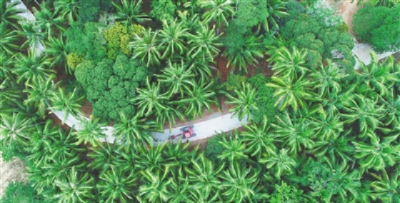
A palm tree grove in Paitian Village, Zhongxing Town, Wenchang. Photo: Yuan Chen, Hainan Daily
Palm Trees: Brave Sea Voyagers

Palm trees in Haitang Bay, Sanya. Photo: Li Yingting, Hainan Daily
Graceful palm trees with lush green fronds waving in the sea breeze - what an iconic tropical island scene! If you haven’t enjoyed the shade of a palm tree or drunk from a fresh-picked coconut on your trip, your Hainan island experience is woefully incomplete!
Although palm trees are quite common here, they are not actually native to the island. Coconut palms originally came from the Melanesian Archipelago and New Zealand. Archaeologists have dug up coconut fossils dating back a million years there. Around 4,000 years ago, the locals began to cultivate the tree.
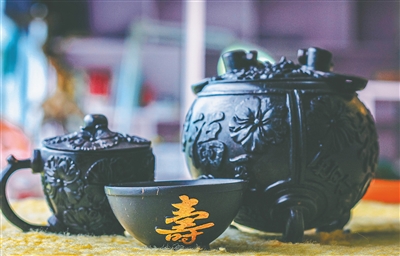
Carved coconut products. File photo
Coconut shells are both sturdy and lightweight, with fibrous wood containing a great deal of air. That’s perfect for floating! When a ripe coconut falls onto the beach or into the sea, it bobs along cheerfully in the warm ocean currents until it arrives on some suitable shore, where it springs to life and sprouts a baby palm tree. One by one, the new trees begin to multiply and spread, soon creating a forest of coconut palms where there were none before. Coconuts are often carried along by the currents of the South China Sea from the coasts of Melanesia and Indochina, and swept up onto the beaches of Hainan. The coast of Wenchang, located in northeast Hainan, sticks out into the ocean like a giant hand dipping into the sea. The summer ocean currents carry wave after wave of ripe coconuts onto the southern shores of Wenchang, which provides the perfect place for them to put down roots and grow big and tall.
“Half of Hainan’s coconuts come from Wenchang, and half of Wenchang’s coconuts come from Dongjiao”. In Wenchang’s Dongjiao Coconut Grove area, a vast forest of palm trees covers the land as far as the eye can see. Their long, straight, narrow trunks seem to touch the sky - they can grow fifteen to thirty meters tall. The interlocking palm fronds sway and whisper in the wind, creating a leafy green roof that blocks even the brightest tropical sunlight and providing a cool, welcome shade.
Rubber Trees: Black Gold
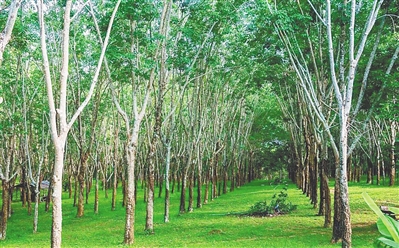
A rubber tree farm. Photo: Zhang Mao, Hainan Daily
In Hainan, from the northern coastal plains to the forests of Wuzhishan, from the foot of Limu Mountain to Chess Bay in Changjiang, you will find forests of lush green rubber trees everywhere. Hainan ranks in the top half of Chinese provinces both in terms of the amount of land covered by rubber tree plantations as well as in rubber production, and is the nation’s largest natural rubber production base.
Rubber trees are deciduous trees in the Euphorbiaceae family, and can grow up to 30 meters tall. These trees love the heat and hate the cold, and normally grow and produce rubber best at temperatures between 20 and 30 degrees Centigrade. If temps drop below 5 degrees, it can cause serious harm to the tree. Mature rubber trees have thick, sold trunks, with veins of milky latex, which is used to make rubber, running throughout.
Those in the rubber farming industry know that workers must go out at night to make incisions in the rubber trees to collect latex. That’s because the sun shines on the trees during the day, and the tree converts the sunshine to energy using photosynthesis. This sets off several chemical reactions inside the rubber tree trunk, generating latex. In the evening, the trunk is full of the day’s deposits of newly formed latex, and as the temperature drops with nightfall, the latex flows more freely, making this the perfect time for collection.
Although now rubber trees are widely cultivated in Hainan, they were only introduced to the island a little more than a hundred years ago. At first, rubber trees only grew in Brazil’s Amazon Rainforest Valley. The rainforest tribes discovered that when they cut these trees with a knife, a milky white liquid ran from the cut. After this liquid dried, it was waterproof, didn’t easily rot, and was elastic as well. They called the rubber tree “cauuchu”, which means “Tree that Cries”. The tears of this crying tree were actually rubber latex.
In the 20th century, the automobile industry began a period of rapid development and expansion, and the demand for rubber products grew along with it. For a time, natural rubber was called “black gold”. Around 1906, He Linshu and other patriotic overseas Chinese brought rubber tree seeds or sprouts to Hainan from Southeast Asia, and began the island’s love affair with this terrific tree.
Betel Nut: Beads of Jade
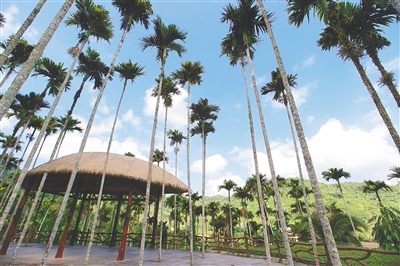
Betel nut trees. Photo: Zhang Mao, Hainan Daily
For the Hainanese, betel nut trees feel just as familiar as coconut palms. The tree trunks are tall, slender and straight, and the flowers emit a delicate fragrance. The trees are even used in landscaping by many due to their elegant appearance. Their fruit, the betel nut, is sold by street vendors and shops alike all across the island.
The Betel Nut Palm is green all year round, and grows over ten meters tall. This tree is not only beautiful to look at, but provides great economic value for Hainan. Unlike other trees, betel nut flowers open not on the branches, but on the tree trunk itself. Every year in March, flower buds begin to peep out from the tree trunks, and soon the flowers begin to bloom. Throughout the summer, the flowers gradually turn from gold to green, and produce fruit that resembles jade beads on a string. These are of course, the betel nuts that the tree is named for. The nuts cluster tightly together at the base of the leaves, making passersby marvel at the tree’s generous bounty. A mature betel nut tree can produce several hundred betel nuts each year, fruiting again and again for over 20 years, after which it gradually begins to wither.
Yellow Rosewood: Each Piece a Work of Art
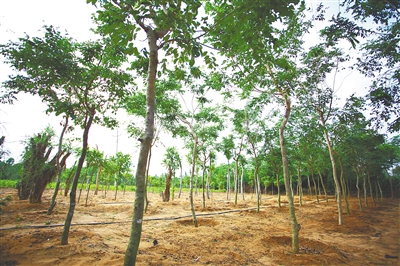
Yellow rosewood trees. Photo: Zhang Mao, Hainan Daily
Hainan’s yellow rosewood pieces each show a unique pattern of marbling, some resembling tiger stripes, others seeming to show figures or faces emerging from the wood. Each piece, no matter the pattern, has the power to draw your gaze and hold it, making this wood a highly sought after commodity.
In the past, this tree was known simply as rosewood, but later Hainan’s trees became known as yellow rosewood. The ‘tiger stripes’ are actually the wood’s irregular pattern of wood grain, which look like decorative designs, and the figures or faces are formed by forks or injuries in the wood, which creates concentrated areas of overlapping wood grain. The wood grain is sometimes straight and sometimes crooked, sometimes sparse and sometimes crowded together, sometimes thick and sometimes thin, sometimes dark and sometimes light, making each piece of wood into a unique piece of art. No two are ever exactly the same!
The thickness of the wood grain, depth of color and luster, oiliness, and size of pores of Hainan’s yellow rosewood is determined by the environment that the tree grows in, the tree’s age, and where the material was collected. Even different pieces of wood from the same tree can have quite large differences!
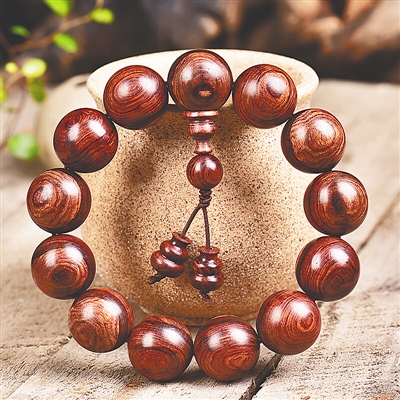
Yellow rosewood bracelet. File Photo
What’s the most important thing for cultivating quality yellow rosewood? As the saying goes, it’s “location, location, location”. The northeastern area of Hainan’s fertile soil and plentiful rainfall makes yellow rosewood grow quickly, creating strong, thick wood grain patterns and excellent texture, as well as wood with a yellow tint. Due to the poorer quality soil and less precipitation in Hainan’s central and southwest regions, yellow rosewood tends to grow more slowly there, resulting in fainter, less well defined grain and reddish or brownish wood color. Some people mature faster than others, and timber is the same. Yellow rosewood is a typical example of the proverb ‘Rome was not built in a day’. To produce wood of high quality, yellow rosewood trees need to grow for over one hundred years.
No matter if the timber is freshly cut or well aged, no matter if it’s hidden underground or lying exposed in the wilderness, as soon as the bark is removed from Hainan’s yellow rosewood, a sweet scent arises. Due to this wonderful quality, even yellow rosewood sawdust is precious - it’s collected and processed into essential oils or high-end perfumes. Experts can even tell the difference between genuine and fake Hainan yellow rosewood while blindfolded. The scent gives the game away!
Agarwood: True Beauty comes from Pain
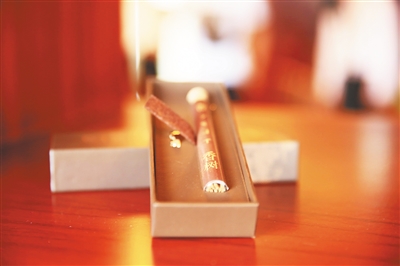
Agarwood incense. Photo: Zhang Mao, Hainan Daily
Agarwood, also known as eaglewood, has been known since ancient times as one of China’s “four traditional fragrances”. Agarwood is formed in nature by chance events and the passage of time. When an agarwood tree is hit by lightning, or damaged by high winds, pests, or disease, the tree secretes a resin in order to seal the wound. Decades or even centuries later, this old wound slowly turns into the fragrant mixture of wood and oil that is known as agarwood.
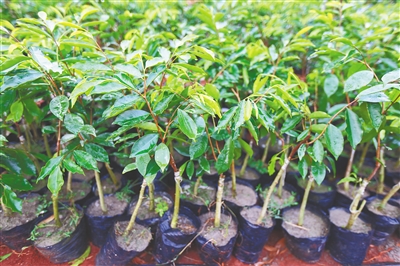
Agarwood sprouts at an agricultural base in Longhu Town, Ding’an. Photo: Zhang Mao, Hainan Daily
Agarwood is classed into several different grades based on the cause of the original injury. “Live” agarwood is agarwood that is produced in the heart of a living agarwood tree, while “pest” agarwood was created due to insect damage to the trunk.
Since ancient times, agarwood, which looks like an unremarkable piece of rotten wood, has been prized for its unique fragrance and medicinal qualities. Agarwood produced in Hainan is also known as “Yaxiang” or “Qiongzhi”. The fragrance of agarwood from Hainan is known for being pure, sweet, and long lasting, with no burnt undertones. It can even be said that Hainan agarwood is “more precious than gold or silver”.
According to experts, wild agarwood can be found in Hainan mainly in the areas of Bawang Ridge, Diaoluo Mountain, and Jianfeng Ridge. It’s exceedingly rare. Currently, agarwood is being farmed in many parts of Hainan, including Tunchang, Ding’an, Dongfang, Baoting, Lingshui, Qiongzhong, Lingao, and Baisha. As agarwood matures slowly, however, production rates are low, making agarwood a highly sought after item in the market. As more and more wild agarwood is harvested, the remaining supply continues to dwindle, so finding high quality wild agarwood in Hainan is getting more and more difficult.
Tea Oil Camellia: Short but Mighty
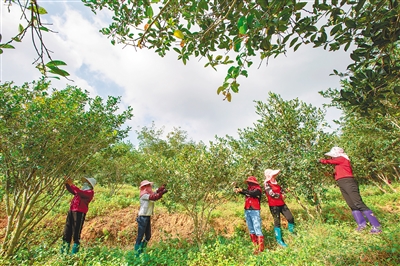
Workers harvesting tea oil camellia at an agricultural base in Wanquan Town, Qionghai. Photo: Yuan Chen, Hainan Daily
Tea oil comes from an ancient type of tree originating in China, where it is known as one of the “Four Great Oil Plants”. The other three are oil palms, coconuts, and Chinese olives.
If the tall, upright palm tree is a brave warrior, the short, squat tea oil camellia tree is a plump, pampered princess. This princess has a refined, elegant appearance, with dark green glossy leaves, and snow white flowers with a bright yellow center. The fruit resembles a little lightbulb, light green at first and then ripening into a reddish brown. Although these mountain trees are rather petite, they are not at all delicate. Even on a barren, rocky mountaintop, they can put down roots. In China’s hilly Jiangxi and Hunan regions, there are vast tracts of tea oil camellia trees.
Every part of the tea oil camellia tree is a treasure. The tender, new leaves are edible, and the oil is highly nutritious. It’s recommended as a healthy edible oil by the Food and Agriculture Organization of the United Nations. It’s even been called the “olive oil of the East”.
The tea oil is also called ‘mountain pomelo’ in Hainan, where oil camellia trees grow a bit bigger, with thicker branches. When tea oil tree sprouts are planted here, it usually takes around 5 years for them to bear fruit. When grafted sprouts are planted, they take around 3 years instead. Oil pressed from Hainan’s tea oil camellias is top notch: clear, pure, and transparent, with a wonderful fragrance.
What Makes "Hainan Travel" So Appealing?
09:38, 11-September-2025100 Days to Go: What's Next for Hainan-Hong Kong Cooperation?
09:38, 11-September-2025Expert Talks Ep. 4: The Future of the FTP's Digital Economy
09:35, 11-September-2025Hainan FTP Tourism & Culture Promotion Wins Hearts In Hong Kong
09:34, 11-September-2025Haikou-Cyprus-Rome Cargo Route Launched
09:36, 10-September-2025Hainan Free Trade Port Promotion and Policy Interpretation Conference Aimed at Advancing Hainan-Hong Kong Cooperation Held in Hong Kong As 100-Day Countdown to Special Customs Operations Begins
09:36, 10-September-2025By continuing to browser our site and use the services you agree to our use of cookies, Privacy Policy and Terms of Use. You can change your cookie settings through your browser.





